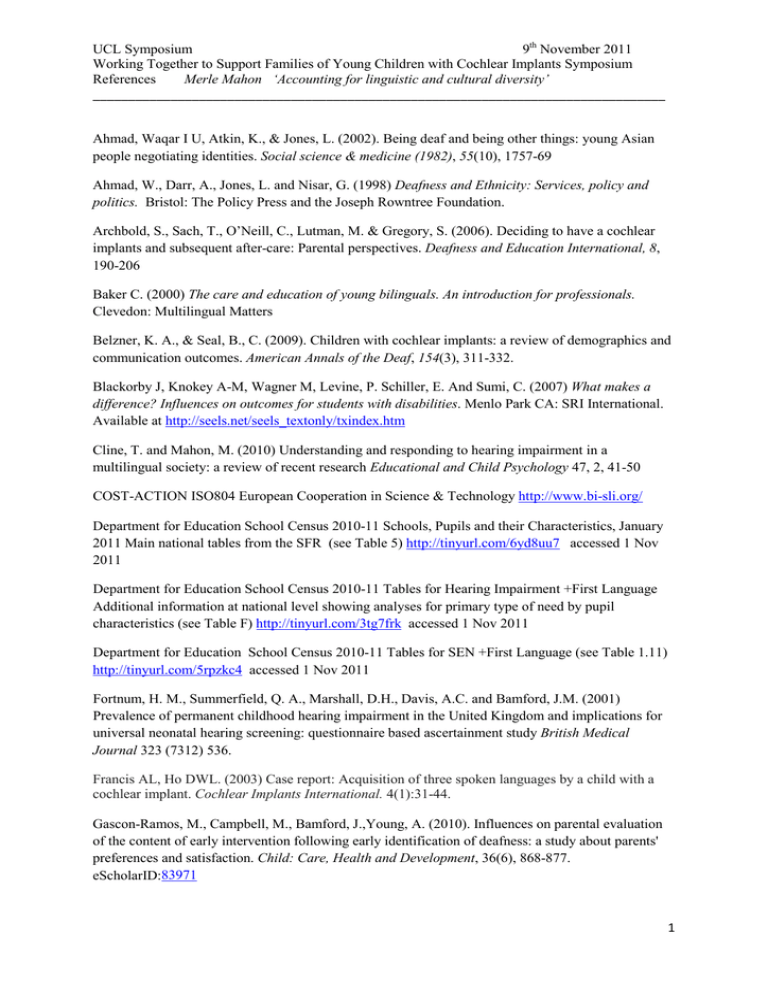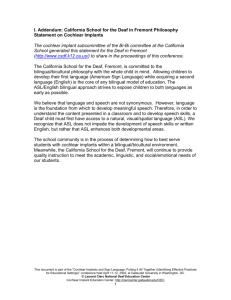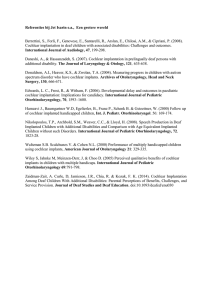th
advertisement

UCL Symposium 9th November 2011 Working Together to Support Families of Young Children with Cochlear Implants Symposium References Merle Mahon ‘Accounting for linguistic and cultural diversity’ _________________________________________________________________________________ Ahmad, Waqar I U, Atkin, K., & Jones, L. (2002). Being deaf and being other things: young Asian people negotiating identities. Social science & medicine (1982), 55(10), 1757-69 Ahmad, W., Darr, A., Jones, L. and Nisar, G. (1998) Deafness and Ethnicity: Services, policy and politics. Bristol: The Policy Press and the Joseph Rowntree Foundation. Archbold, S., Sach, T., O’Neill, C., Lutman, M. & Gregory, S. (2006). Deciding to have a cochlear implants and subsequent after-care: Parental perspectives. Deafness and Education International, 8, 190-206 Baker C. (2000) The care and education of young bilinguals. An introduction for professionals. Clevedon: Multilingual Matters Belzner, K. A., & Seal, B., C. (2009). Children with cochlear implants: a review of demographics and communication outcomes. American Annals of the Deaf, 154(3), 311-332. Blackorby J, Knokey A-M, Wagner M, Levine, P. Schiller, E. And Sumi, C. (2007) What makes a difference? Influences on outcomes for students with disabilities. Menlo Park CA: SRI International. Available at http://seels.net/seels_textonly/txindex.htm Cline, T. and Mahon, M. (2010) Understanding and responding to hearing impairment in a multilingual society: a review of recent research Educational and Child Psychology 47, 2, 41-50 COST-ACTION ISO804 European Cooperation in Science & Technology http://www.bi-sli.org/ Department for Education School Census 2010-11 Schools, Pupils and their Characteristics, January 2011 Main national tables from the SFR (see Table 5) http://tinyurl.com/6yd8uu7 accessed 1 Nov 2011 Department for Education School Census 2010-11 Tables for Hearing Impairment +First Language Additional information at national level showing analyses for primary type of need by pupil characteristics (see Table F) http://tinyurl.com/3tg7frk accessed 1 Nov 2011 Department for Education School Census 2010-11 Tables for SEN +First Language (see Table 1.11) http://tinyurl.com/5rpzkc4 accessed 1 Nov 2011 Fortnum, H. M., Summerfield, Q. A., Marshall, D.H., Davis, A.C. and Bamford, J.M. (2001) Prevalence of permanent childhood hearing impairment in the United Kingdom and implications for universal neonatal hearing screening: questionnaire based ascertainment study British Medical Journal 323 (7312) 536. Francis AL, Ho DWL. (2003) Case report: Acquisition of three spoken languages by a child with a cochlear implant. Cochlear Implants International. 4(1):31-44. Gascon-Ramos, M., Campbell, M., Bamford, J.,Young, A. (2010). Influences on parental evaluation of the content of early intervention following early identification of deafness: a study about parents' preferences and satisfaction. Child: Care, Health and Development, 36(6), 868-877. eScholarID:83971 1 UCL Symposium 9th November 2011 Working Together to Support Families of Young Children with Cochlear Implants Symposium References Merle Mahon ‘Accounting for linguistic and cultural diversity’ _________________________________________________________________________________ Garcia O, Baker C eds (2007) Bilingual education : an introductory reader. Clevedon Buffalo: Multilingual Matters Geers, A., & Brenner, C. (2003). Background and educational characteristics of prelingually deaf children implanted by five years of age. Ear and Hearing, 24(1 Suppl), 2S-14S Guiberson, M. (2005). Children with cochlear implants from bilingual families: Considerations for intervention and a case study. Volta Review, 105, 29–39. Home Language Environment questionnaire see McCarthy, K. (2009) Accounting for parental language input in bilingual and multilingual families: The development of a ‘home language environment’ questionnaire. MRes Thesis, Division of Psychology and Language Science, UCL. Hyde, M., & Power, D. (2006). Some ethical dimensions of cochlear implantation for deaf children and their families. Journal of Deaf Studies and Deaf Education, 11(1), 102-11. Lindsay, G., Pather, S., & Strand, S. (2006) Special Educational Needs and Ethnicity : Issues of Overand Under-Representation Under-Representation Centre for Educational Development, Appraisal and Research University of Warwick DfE Research Report 757 Available at http://www.naldic.org.uk/docs/resources/documents/RR757.pdf. London SIG Bilingualism http://londonsigbilingualism.co.uk/ NALDIC National Association for Language Development in the Curriculum http://www.naldic.org.uk/ Mahon, M, Vickers, D., McCarthy, K., Barker, R., Merritt, R., Szagun, G., et al. (2011). Cochlearimplanted children from homes where English is an additional language: findings from a recent audit in one London centre. CochlearImplants International, 12(2), 105-13 Mahon, M. (2009). Interactions between a deaf child for whom English is an additional language and his specialist teacher in the first year at school: combining words and gestures. Clinica Linguistics & Phonetics, 23(8), 611-29. Mahon, M., Marinis, T. and Corrin, J. (2010) Words and Gestures in Deaf Children’s Spoken Language Development. Paper presented at conference of the International Clinical Phonetics and Linguistics Association, University of Oslo, June Mahon M (2003) Conversations with young deaf children in families where English is an additional language. In Gallaway C and Young A (Eds) Deafness and Education in the UK: Research Perspectives Whurr Publishers Limited, London. McCarthy, K. (2009) Accounting for parental language input in bilingual and multilingual families: The development of a ‘home language environment’ questionnaire. MRes Thesis, Division of Psychology and Language Science, UCL. Mitchell RE, Karchmer MA. (2011) Demographic and achievement characteristics of deaf and hardof-hearing students. In: Marschark M, Spencer PE, eds. The Oxford Handbook of deaf studies, language and education. Volume 1. Second Ed. Oxford: Oxford University Press; Chapter 2 18-31. 2 UCL Symposium 9th November 2011 Working Together to Support Families of Young Children with Cochlear Implants Symposium References Merle Mahon ‘Accounting for linguistic and cultural diversity’ _________________________________________________________________________________ Moore, J., Prath, S., & Arrieta, A. (2006). Early Spanish speech acquisition following cochlear implantation. Volta Review, 106, 321–341. Mytton, J. and Mackenzie I. (2005) Observed and expected prevalence of permanent childhood hearing impairment in Oldham Journal of Public Health. 27, 3, 298-302. Naeem, Z. and Newton, V. (1996) Prevalence of sensori-neural hearing loss in Asian children. British Journal of Audiology. 30, 5, 332-339. NICE guidelines on CI (2009) http://tinyurl.com/6f7d7fw accessed 1 Nov 2011 Pert, S and Letts, C. (2003) Developing an expressive language assessment for children in Rochdale with a Pakistani heritage background. Child Language Teaching and Therapy 19, (3), 267-289. Pert, S. and Letts, C. (2006). Codeswitching in Mirpuri speaking Pakistani heritage preschool children: bilingual language acquisition. Int Journal of Bilingualism 10(3) 349-374. Pert & Stow http://www.bilingualism.co.uk/ Robbins A.M., Green J., and Waltzman S.B. (2004) Bilingual oral language proficiency in children with cochlear implants. Archives Otolaryngology: head and neck surgery, 130:644-647. Sass-Lehrer M. Early intervention: birth to three. In: Marschark M, Spencer PE, eds. The Oxford Handbook of deaf studies, language and education. Volume 1. Second Ed. Oxford: Oxford University Press; 2011:63-81. SOLOM Montebello Unified School District, Instructional Division. Student Oral Language Observation Matrix. Montebello, Calif: Montebello Unified School District; 1978. Available at http://tinyurl.com/632n9vl Stacey P.C., Fortnum H.M., Barton G.R., Summerfield A.Q. (2006) Hearing-impaired children in the United Kingdom, I: Auditory performance, communication skills, educational achievements, quality of life, and cochlear implantation. Ear and Hearing. Apr;27(2):161-86. Steinberg, A., Bain, L., Li, Y., Delgado, G., & Ruperto, V. (2003). Decisions Hispanic families make after the identification of deafness. Journal of Deaf Studies and Deaf Education, 8(3), 291-314. Stern, R. E., Yueh, B., Lewis, C., Norton, S., & Sie, K. C. Y. (2005). Recent epidemiology of pediatric cochlear implantation in the United States: disparity among children of different ethnicity and socioeconomic status. The Laryngoscope, 115(1), 125-31. Strand, S. and Demie, F. (2005). English language acquisition and educational attainment at the end of primary school. Educational Studies, 13, (3), 275 - 291. Teschendorf M, Janeschik S, Bagus H, Lang S, Arweiler-Harbeck D. (2011) Speech development after cochlear implantation in children from bilingual homes. Otology & Neurotology 32(2):229-35. Thomas, E., El-Kashlan, H. and Zwolan. T.A. (2008). Children with cochlear implants who live in monolingual and bilingual homes. Otology and Neurotology 29 (2), 230-234 Waltzman S, Robbins A.M., Green J.E. and Cohen, N.L.(2003) Second oral language capabilities in children with cochlear implants. Otology and Neurotology 24 (5):757-763. 3 UCL Symposium 9th November 2011 Working Together to Support Families of Young Children with Cochlear Implants Symposium References Merle Mahon ‘Accounting for linguistic and cultural diversity’ _________________________________________________________________________________ Young, A.M., Gascon-Ramos, M., Campbell, M. Bamford, J. (2009). The Design and Validation of a Parent-Report Questionnaire for Assessing the Characteristics and Quality of Early Intervention Over time. Journal of Deaf Studies and Deaf Education, 14 (4) 422-435 DOI:10.1093/deafed/enp016 Zaidman-Zaid, A. (2007). Parenting a child with a cochlear implant: a critical incident study. Journal of Deaf Studies and Deaf Education, 12, 221-241. 4



